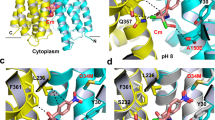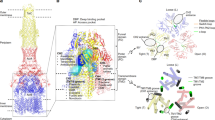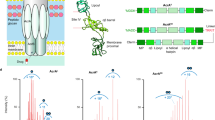Abstract
Multidrug resistance, by which cells become resistant to multiple unrelated pharmaceuticals, is due to the extrusion of drugs from the cell's interior by active transporters such as the human multidrug resistance P-glycoprotein1. Two major classes of transporters mediate this extrusion2,3. Primary-active transporters are dependent on ATP hydrolysis, whereas secondary-active transporters are driven by electrochemical ion gradients that exist across the plasma membrane. The ATP-binding cassette (ABC) transporter LmrA4 is a primary drug transporter in Lactococcus lactis that can functionally substitute for P-glycoprotein in lung fibroblast cells5. Here we have engineered a truncated LmrA protein that lacks the ATP-binding domain. Surprisingly, this truncated protein mediates a proton–ethidium symport reaction without the requirement for ATP. In other words, it functions as a secondary-active multidrug uptake system. These findings suggest that the evolutionary precursor of LmrA was a secondary-active substrate translocator that acquired an ATP-binding domain to enable primary-active multidrug efflux in L. lactis.
This is a preview of subscription content, access via your institution
Access options
Subscribe to this journal
Receive 51 print issues and online access
$199.00 per year
only $3.90 per issue
Buy this article
- Purchase on Springer Link
- Instant access to full article PDF
Prices may be subject to local taxes which are calculated during checkout




Similar content being viewed by others
References
Ambudkar, S. V. et al. Biochemical, cellular and pharmacological aspects of the multidrug transporter. Annu. Rev. Pharmacol. Toxicol. 39, 361–398 (1999)
Higgins, C. F. ABC transporters: from microorganisms to man. Annu. Rev. Cell Biol. 8, 67–113 (1992)
Paulsen, I. T., Brown, M. H. & Skurray, R. A. Proton-dependent multidrug efflux systems. Microbiol. Rev. 60, 575–608 (1996)
Van Veen, H. W. et al. Multidrug resistance mediated by a bacterial homolog of the human drug transporter MDR1. Proc. Natl Acad. Sci. USA 93, 10668–10672 (1996)
Van Veen, H. W. et al. A bacterial antibiotic-resistance gene that complements the human multidrug-resistance P-glycoprotein gene. Nature 391, 291–295 (1998)
Van Veen, H. W. et al. The homodimeric ATP-binding cassette transporter LmrA mediates multidrug transport by an alternating two-site (two-cylinder engine) mechanism. EMBO J. 19, 2503–2514 (2000)
Chang, G. & Roth, C. B. The structure of MsbA from E. coli: a homolog of the multidrug resistance ATP binding cassette (ABC) transporters. Science 293, 1793–1800 (2001)
Chang, G. Structure of MsbA from Vibrio cholera: a multidrug resistance ABC transporter homolog in a closed conformation. J. Mol. Biol. 330, 419–430 (2003)
Putman, M., Van Veen, H. W., Degener, J. E. & Konings, W. N. Antibiotic resistance: era of the multidrug pump. Mol. Microbiol. 36, 772–774 (2000)
Kaback, H. R. in The Bacteria Vol. 12 (Bacterial Energetics) (ed. Krulwich, T. A.) 151–193 (Academic, London, 1990)
Sharom, F. J., Yu, X. & Doige, C. A. Functional reconstitution of drug transport and ATPase activity in proteoliposomes containing partially purified P-glycoprotein. J. Biol. Chem. 268, 24197–24202 (1993)
Eytan, G. D., Regev, R. & Assaraf, Y. G. Functional reconstitution of P-glycoprotein reveals an apparent near stoichiometric drug transport to ATP hydrolysis. J. Biol. Chem. 271, 3172–3178 (1996)
Booth, I. R. Regulation of cytoplasmic pH in bacteria. Microbiol. Rev. 49, 359–378 (1985)
Kroll, R. G. & Booth, I. R. The relationship between intracellular pH, the pH gradient and potassium-transport in Escherichia coli. Biochem. J. 216, 709–716 (1983)
Bakker, E. P. Alkali Cation Transport Systems in Prokaryotes (CRC Press, Florida, 1993)
Thiebaut, F. et al. Activity of the multidrug transporter results in alkalinization of the cytosol: measurement of cytosolic pH by microinjection of a pH-sensitive dye. J. Histochem. Cytochem. 38, 685–690 (1990)
Landwojtowicz, E., Nervi, P. & Seelig, A. Real-time monitoring of P-glycoprotein activation in living cells. Biochemistry 41, 8050–8057 (2002)
Santai, C. T., Fritz, F. & Roepe, P. D. Effects of ion gradients on H+transport mediated by human MDR1 protein. Biochemistry 38, 4227–4234 (1999)
Howard, E. M. & Roepe, P. D. Purified human MDR1 modulates membrane potential in reconstituted proteoliposomes. Biochemistry 42, 3544–3555 (2003)
Kuroda, M., Dey, S., Sanders, O. I. & Rosen, B. P. Alternate energy coupling of ArsB, the membrane subunit of the Ars anion-translocating ATPase. J. Biol. Chem. 272, 326–331 (1997)
Margolles, A., Putman, M., Van Veen, H. W. & Konings, W. N. The purified and functionally reconstituted multidrug transporter LmrA of Lactococcus lactis mediates the transbilayer movement of specific fluorescent phospholipids. Biochemistry 38, 16298–16306 (1999)
Reuter, G. et al. The ATP-binding cassette multidrug transporter LmrA and lipid transporter MsbA have overlapping substrate specificities. J. Biol. Chem. 278, 35193–35198 (2003)
Janvilisri, T. et al. Sterol transport by the human breast cancer resistance protein (ABCG2) expressed in Lactococcus lactis. J. Biol. Chem. 278, 20645–20651 (2003)
Breeuwer, P., Drocourt, J., Rombouts, F. M. & Abee, T. A novel method for continuous determination of the intracellular pH in bacteria with the internally conjugated fluorescent probe 5 (and 6-)-carboxyfluorescein succinimidyl ester. Appl. Environ. Microbiol. 62, 178–183 (1996)
Novo, D., Perlmutter, N. G., Hunt, R. H. & Shapiro, H. M. Accurate flow cytometric membrane potential measurement in bacteria using diethyloxacarbocyanine and a ratiometric technique. Cytometry 35, 55–63 (1999)
Van Veen, H. W., Abee, T., Kortstee, G. J. J., Konings, W. N. & Zehnder, A. J. B. Mechanism and energetics of the secondary phosphate transport system of Acinetobacter johnsonii 210A. J. Biol. Chem. 268, 19377–19383 (1993)
Acknowledgements
We thank Chris Higgins, Peter McNaughton, Ben Luisi, and Ian Booth for stimulating discussions. This research was funded by Cancer Research UK, the Association of International Cancer Research (AICR), the Biotechnology and Biological Sciences Research Council (BBSRC), the Medical Research Council (MRC), the Royal Society, and Molecular Devices Ltd. S.V. was the recipient of a Cambridge Nehru Scholarship.
Author information
Authors and Affiliations
Corresponding author
Ethics declarations
Competing interests
The authors declare that they have no competing financial interests.
Rights and permissions
About this article
Cite this article
Venter, H., Shilling, R., Velamakanni, S. et al. An ABC transporter with a secondary-active multidrug translocator domain. Nature 426, 866–870 (2003). https://doi.org/10.1038/nature02173
Received:
Accepted:
Issue Date:
DOI: https://doi.org/10.1038/nature02173
This article is cited by
-
Complexities of a protonatable substrate in measurements of Hoechst 33342 transport by multidrug transporter LmrP
Scientific Reports (2020)
-
Multidrug efflux pumps: structure, function and regulation
Nature Reviews Microbiology (2018)
-
ATP-dependent substrate transport by the ABC transporter MsbA is proton-coupled
Nature Communications (2016)
-
Relocation of active site carboxylates in major facilitator superfamily multidrug transporter LmrP reveals plasticity in proton interactions
Scientific Reports (2016)
-
Thermodynamics of ABC transporters
Protein & Cell (2016)
Comments
By submitting a comment you agree to abide by our Terms and Community Guidelines. If you find something abusive or that does not comply with our terms or guidelines please flag it as inappropriate.



